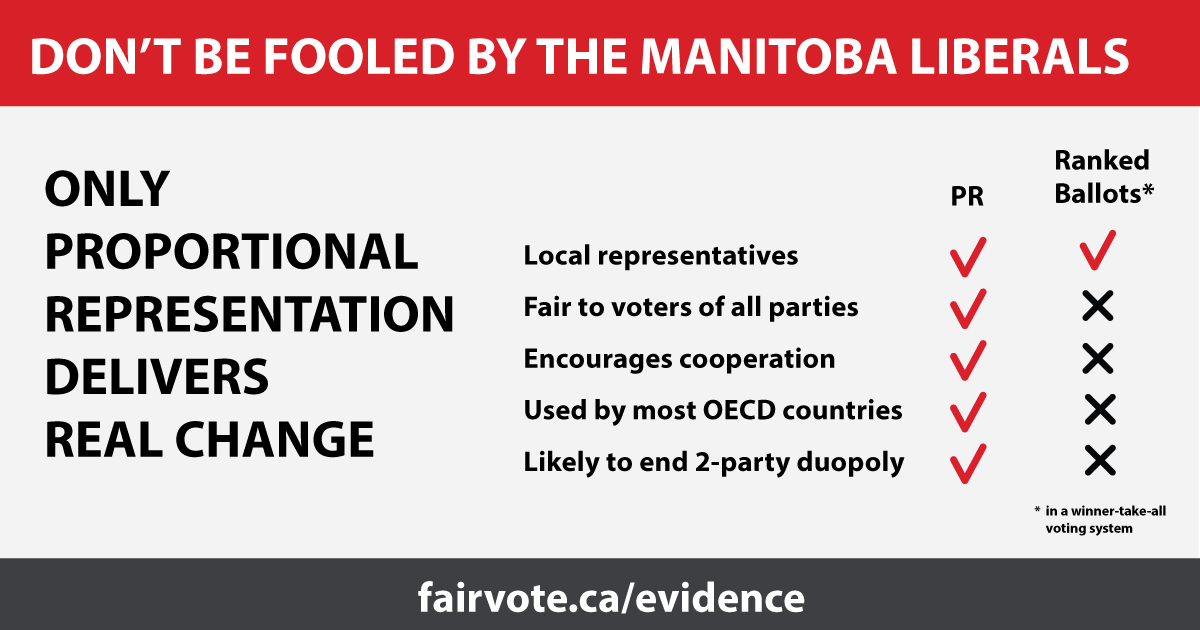
The Manitoba Liberals have offered an unserious non-solution to the very real democratic deficit Manitoba is facing.
Liberal Leader Dougald Lamont rightly points to the lack of choice Manitobans face at the ballot box, with voters in the vast majority of ridings offered the choice of one or sometimes two candidates with a realistic hope of entering the legislature. The lack of competition fosters complacency and bad governance, neither of which Manitobans deserve.
Unfortunately, pasting a ranked ballot onto single-member ridings does nothing to address that.
To be impactful, rankings have to actually affect the results, and under Lamont’s proposed system they simply do not. That is evident from the track record of this system’s use in rural Manitoba ridings between 1927 and 1953, where rankings only impacted the outcome in 2% of races and less than half of voters even bothered to rank more than one candidate.
If Manitoba had used Lamont’s version of ranked ballots in 2019, only one seat was close enough to change hands―the riding of McPhillips. In 39 of 57 ridings, one party or another already had a majority of the vote, meaning rankings would not even come into play.
Lamont opines that his “reform” would end the two-party duopoly, but in the five Australian state legislatures using his preferred system, in no case does a third party enjoy as strong a presence in their legislatures as the Liberals do in Manitoba currently.
It would still take more than three times as many votes to elect a Liberal as a Progressive Conservative, and 30,000 Manitoba Greens would still be without any representation in the legislature. This is a far cry from the Manitoba Liberals’ 2016 promise to make every vote count with proportional representation!
Lamont further claims that his do-nothing proposal would improve turnout, but the evidence doesn’t support this: when Manitoba adopted winner-take-all ranked ballots previously, turnout actually dropped.
So why push these “reforms” if the Manitoba Liberals and Greens would not see any relief from their current plight? I see two possibilities.
The first is that Lamont may simply have not done his homework. He may not be aware of how little his proposal actually accomplished when used previously in Manitoba or currently in Australia.
The second is that Lamont is indeed aware of how little his proposal would accomplish even for his own party, and is instead acting in the short-term interests of his federal friends rather than his own voters.
Manitobans deserve real solutions to real problems, not phony reforms. Manitoba Liberal voters are genuinely shortchanged by the electoral system―in 2019, 14% of voters chose Liberal candidates, but they only elected 5% of MLAs. It’s unfortunate that even their own party leader isn’t willing to propose a reform that would correct that.
For a better solution, Manitobans could look into their own past to see the proportional form of ranked ballots used in Winnipeg―the Single Transferable Vote. Under that option, voters would not just have meaningful choices between different parties, but also between different candidates of the same party. When adopted in Winnipeg, turnout increased, even when it declined elsewhere in the province.
Or better yet, they could look at the Manitoba Green’s proposall for a non-partisan Citizens’ Assembly on Electoral Reform. That would be the best way to ensure that the interests of voters―not politicians―are prioritized.
Either way, electoral reform should be based on evidence with input from citizens—not just treated as a toy without regard for real world experience.

Ryan Campbell has been a member of Fair Vote Canada’s national board since 2021. He also served on the national board from 2012 to 2015.
